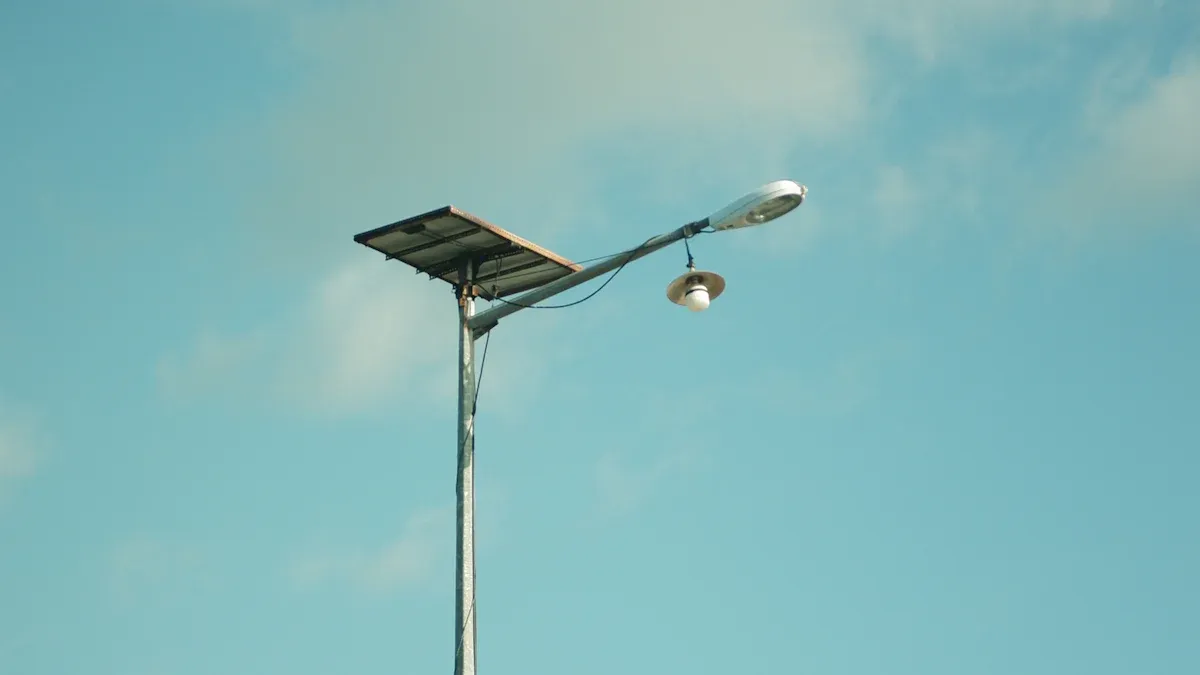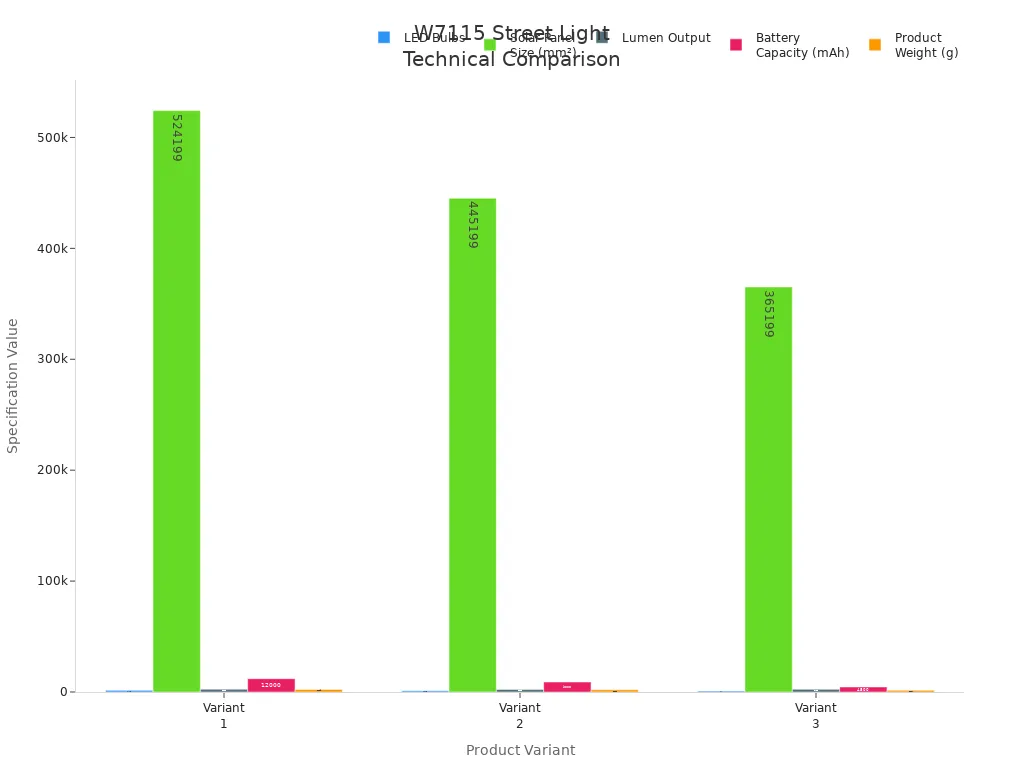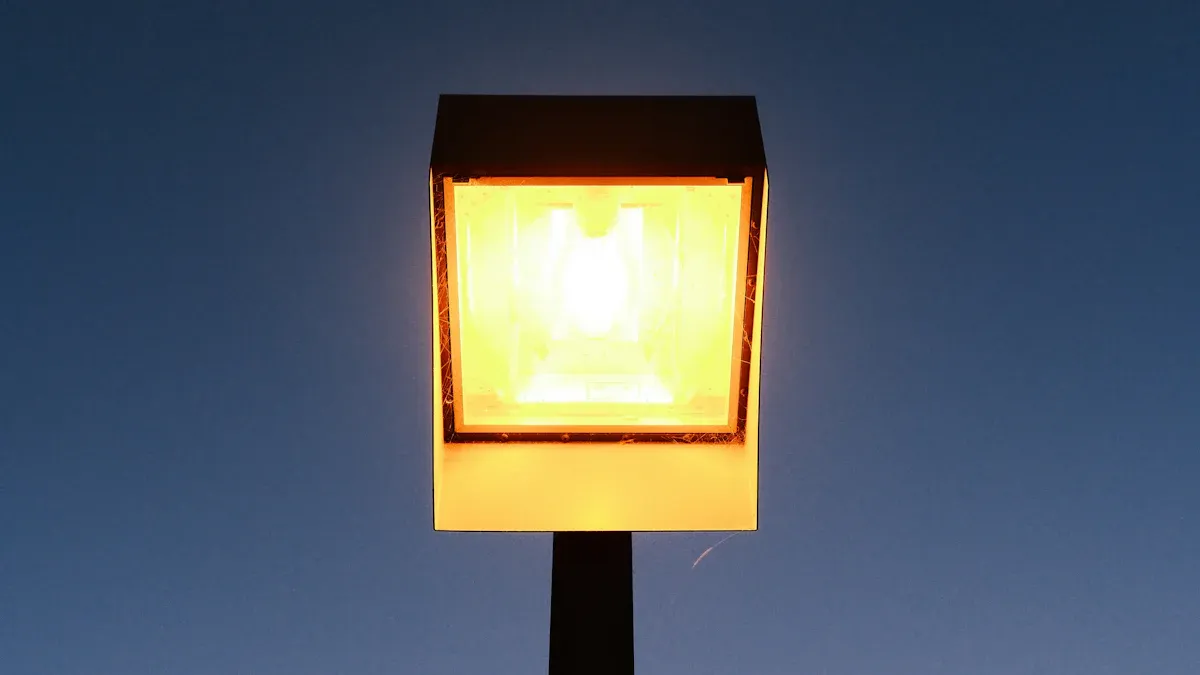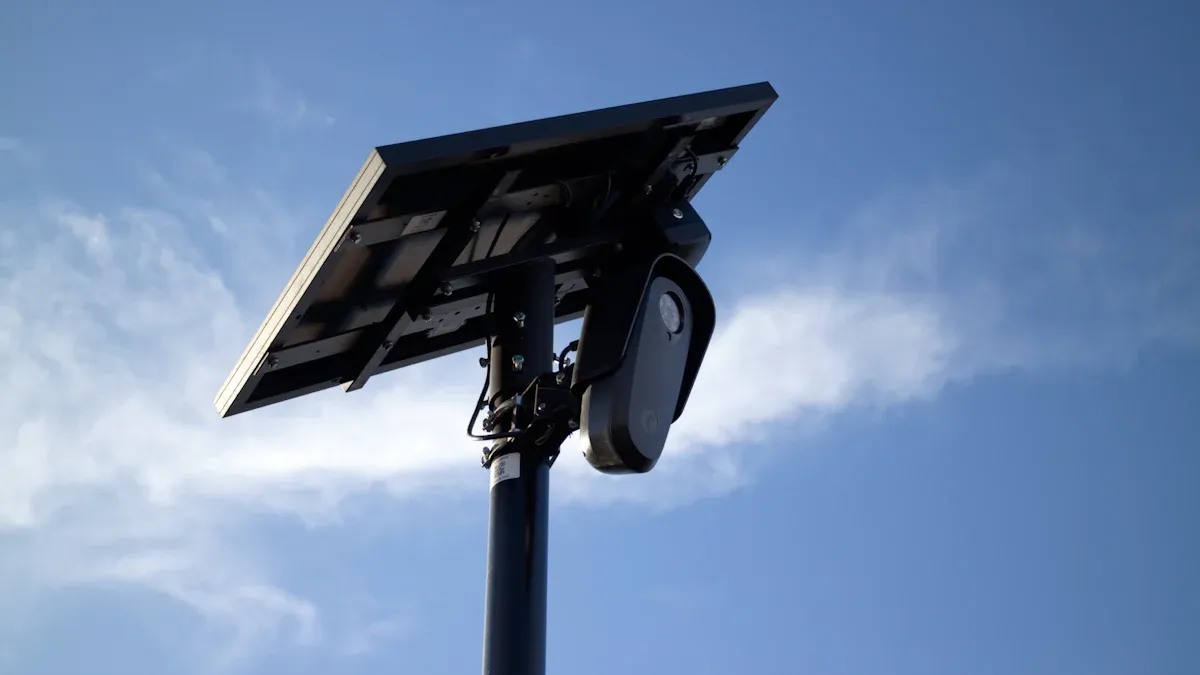
When I choose a Solar Street Light, I look for brightness, battery life, and weather resistance. The W7115 High Lumen Outdoor Remote Control Waterproof Home Solar Induction Street Light stands out for its reliability.
- Solar Powered Street Lights now lead 41.8% of the outdoor LED market.
- Waterproof Ip65 All In One Led Solar Street Light models remain popular for durability.
W7115 High Lumen Outdoor Remote Control Waterproof Home Solar Induction Street Light Overview
Main Features and Benefits
When I look for a reliable solar street light, I focus on features that deliver both performance and convenience. The W7115 High Lumen Outdoor Remote Control Waterproof Home Solar Induction Street Light stands out with its durable ABS+PS construction. This material resists impact and harsh weather. I appreciate the high-efficiency SMD 2835 LED lamp beads, which provide up to 2500 lumens of brightness. The light offers three working modes, so I can adjust it for different outdoor spaces like gardens, courtyards, or parking lots. The remote control makes it easy to switch modes or adjust settings from a distance.
Here is a quick overview of the key specifications:
| Specification Category | Details |
|---|---|
| Product Material | ABS+PS (durable and impact resistant) |
| LED Bulbs | SMD 2835 LED lamp beads: 1478 / 1103 / 807 (depending on model) |
| Lumen Output | Approximately 2500Lm / 2300Lm / 2400Lm |
| Solar Panel Size | 524199mm / 445199mm / 365*199mm |
| Battery Configuration | 8 x 18650 (12000mAh), 6 x 18650 (9000mAh), 3 x 18650 (4500mAh) |
| Working Modes | 1) Human body sensing 2) Dim + strong light sensing 3) Weak light constant mode |
| Intelligent Sensing | Light and infrared human body sensing |
| Waterproof Capability | Stable in various weather conditions |
| Battery Life | 4-5 hours continuous, up to 12 hours in human sensing mode |
| Product Dimensions & Weight | 22660787mm (2329g), 22660706mm (2008g), 22660625mm (1584g) |
| Accessories Included | Remote control, expansion screw package |
| Application Scenarios | Indoor/outdoor: courtyards, corridors, gardens, parking lots |
| Unique Selling Points | Intelligent sensing, energy-saving, multiple modes, remote control, waterproof |
| Manufacturer Experience | Over 20 years in outdoor LED product R&D and production |
I find that these features make the W7115 model a strong choice for anyone who needs reliable, energy-saving lighting outdoors.
How the Solar Induction System Works
I value how the solar induction system combines smart technology with energy efficiency. The light uses a high-efficiency solar panel to collect sunlight during the day. It stores this energy in a powerful lithium battery. At night, the intelligent sensing system takes over. The light turns on automatically when it detects motion or low ambient light. I can choose between three modes: bright light when someone passes by, dim light that brightens with movement, or a constant weak light for all-night illumination.
The chart below shows how the three W7115 models compare in LED count, solar panel size, lumen output, battery capacity, and weight:

This system ensures that I get bright, reliable lighting while saving on electricity and maintenance. The waterproof design means I can trust it to work in rain, snow, or humidity.
Evaluating Brightness and Lumen Output

Importance of High Lumen Performance
When I choose outdoor lighting, I always check the lumen output first. Lumen measures how much visible light a lamp produces. High lumen performance means the light shines brighter and covers more area. Research shows that bright, consistent lighting improves safety outside. It helps me see obstacles and keeps my property secure by deterring unwanted visitors. Good lighting also reduces the risk of accidents in busy areas like walkways and entrances. I find that matching the brightness to the space is important for both safety and comfort.
Here is a quick comparison of typical lumen ranges:
| Lighting Type | Typical Lumen Range |
|---|---|
| W7115 Solar Street Light | 2300 to 2500 lumens |
| Commercial Street Lights | 1000 to 10,000 lumens |
The W7115 model fits well for home courtyards, corridors, and gardens. Its lumen output provides enough brightness for most residential needs.
Selecting the Right Brightness for Your Space
I use a few simple guidelines to pick the right brightness for each area. Lighting experts recommend measuring light levels at several points between poles and road edges. This helps ensure even coverage. I look for uniformity ratios above 0.6 in work areas for visual comfort. For roads and paths, a ratio of at least 0.35 to 0.4 keeps lighting safe and prevents eye strain.
- The Nine-Point Method measures lux at key points for accurate results.
- Average illuminance uses weighted sums of these measurements.
- Uniformity ratios (U1 and U2) show how evenly the light spreads.
- Grids should have points less than half the pole height or 4.5 meters apart.
- The Equal Space Method uses at least 10 points between poles, spaced no more than 5 meters apart.
- Lighting standards suggest minimum/average ratios from 0.3 to 0.8, depending on the area.
By following these steps, I make sure my outdoor lighting is both bright and comfortable.
Battery Capacity and Type
Understanding Battery Specifications and Lifespan
When I select a solar street light, I always check the battery type and capacity first. The battery acts as the heart of the system. The W7115 model uses high-performance 18650 lithium-ion batteries. These batteries come in different capacities: 4500mAh, 9000mAh, and 12000mAh. Higher capacity means the light can run longer through the night and handle more cloudy days. I find that lithium-ion batteries offer a strong balance between energy storage and weight.
Most lithium-ion batteries in solar street lights last between 5 and 8 years under normal use. Over time, the battery’s ability to hold a charge slowly drops. I plan for this gradual decline by choosing a model with a larger battery when I need longer lighting hours. I also look for clear battery specifications in the product details to make sure I get the right fit for my needs.
Battery Performance and Maintenance
To keep my solar street light working well, I follow a few simple maintenance steps. Good battery care helps me get the most out of my investment and keeps the light shining bright for years.
Tip: Regular maintenance can extend battery life and prevent sudden failures.
Here are some best practices I use:
- I make sure the battery compartment stays sealed to keep out rainwater.
- I check that the charging and discharging voltages stay within safe limits.
- I try to keep the battery at a steady temperature, around 25°C, for best performance.
- I avoid letting the battery fully discharge or overcharge.
- I test the battery’s capacity and replace it if I notice a big drop in performance.
- I clean the terminals and check for corrosion during routine inspections.
By following these steps, I help my solar street light battery last as long as possible and keep my outdoor spaces well-lit.
Solar Panel Quality and Efficiency

Types of Solar Panels Used
When I choose a solar street light, I always check the type of solar panel it uses. The panel type affects how much sunlight the light can turn into electricity. Most high lumen solar street lights use monocrystalline panels. These panels work well because they have high energy conversion rates and perform better in cold weather. I see that polycrystalline panels appear less often in these lights because they do not convert sunlight as efficiently. Some newer models use half-cell mono panels or PERC HJT solar PV panels, but these are not as common for street lighting.
Here is a table that shows the main types of solar panels and their efficiency:
| Solar Panel Type | Common Usage in High Lumen Solar Street Lights | Efficiency (%) |
|---|---|---|
| Monocrystalline | Most commonly used due to higher energy conversion and better performance, especially in cold weather | Up to 24.1% (Sunpower panels) |
| Polycrystalline | Used less frequently, lower efficiency compared to monocrystalline | Lower than monocrystalline |
| Half-cell Mono Panels | Mentioned as high-efficiency options but less emphasized for street lights | N/A |
| PERC HJT Solar PV Panels | Also noted as high-efficiency types but not primary for street lights | N/A |
Tip: Monocrystalline panels give you the best performance for most outdoor lighting needs.
Charging Speed and Energy Conversion
I always look for solar panels that charge quickly and convert sunlight efficiently. A high-quality panel can store enough energy during the day to power the light all night. Monocrystalline panels stand out because they reach up to 24.1% efficiency. This means they turn more sunlight into usable power, even on cloudy days. Fast charging helps the battery fill up before sunset, so I never worry about the light running out at night. I recommend checking the panel size and placement to get the best results. Clean panels also work better, so I wipe them down regularly to keep them free from dust and debris.
Waterproof Rating and Weather Resistance
Understanding IP Ratings
When I choose outdoor lighting, I always check the IP rating. IP stands for “Ingress Protection.” This rating tells me how well the light keeps out dust and water. The first number shows protection against solid objects like dust. The second number shows protection against liquids like rain. For example, an IP65 rating means the light is dust-tight and can handle water jets from any direction. I look for at least IP65 in my outdoor lights. This gives me confidence that the light will work in tough weather.
Tip: Always check the product label for the IP rating before buying. A higher number means better protection.
Here is a simple table to help understand IP ratings:
| IP Rating | Dust Protection | Water Protection |
|---|---|---|
| IP44 | Limited | Splashing water |
| IP65 | Complete | Water jets |
| IP67 | Complete | Temporary immersion |
Performance in Rain, Snow, and Humidity
I want my solar street light to work in all seasons. I have seen how rain, snow, and humidity can damage outdoor lights. With a high IP rating, my light keeps working even during heavy storms. The sealed design stops water from getting inside. I never worry about snow piling up or humid air causing rust. I also check that the light uses strong materials like ABS and PS. These materials resist cracking and fading. My outdoor spaces stay bright and safe, no matter the weather.
Remote Control and Intelligent Sensing Functions
Remote Control Features and Modes
I find that the remote control adds a new level of convenience to my outdoor lighting. With the remote, I can switch between different lighting modes without leaving my porch or yard. The remote lets me adjust brightness, set timers, and choose the working mode that fits my needs. I often use the remote to switch to the human body sensing mode when I expect visitors. For quiet nights, I select the weak light constant mode. The remote control makes it easy to customize the light for any situation.
Here are some features I use most often with the remote:
- Change between three lighting modes
- Adjust brightness levels
- Set automatic timers for energy savings
- Turn the light on or off from a distance
Tip: Keep the remote in a safe place so you can always adjust your lighting quickly.
Motion and Light Sensing Capabilities
I rely on the intelligent sensing system to keep my outdoor spaces safe and efficient. The light uses both infrared motion sensors and light sensors. During the day, the light turns off automatically to save energy. At night, the motion sensor detects movement and activates the bright mode. This feature helps me feel secure when I walk outside after dark. The light also senses changes in ambient light, so it only turns on when needed.
The intelligent sensing system offers these benefits:
- Saves energy by turning on only when motion is detected
- Provides bright light instantly when someone approaches
- Adjusts to changing daylight conditions for maximum efficiency
I trust these smart features to deliver reliable and responsive lighting every night.
Installation Requirements and Options
Mounting Methods and Placement
When I install a solar street light, I always plan the placement first. I mount the light at a height between 4 and 6 meters. This height gives me the best balance between brightness and coverage. I space multiple lights 20 to 25 meters apart. This spacing helps me avoid dark spots and ensures even lighting. I make sure the solar panel faces south if I live in the Northern Hemisphere. If I live in the Southern Hemisphere, I point it north. This orientation lets the panel collect the most sunlight each day.
I avoid shaded areas caused by trees or buildings. Shade can block sunlight and reduce charging. I use sturdy poles or walls that can support the weight of the light. I fasten the mounting bracket tightly. I also check that I can reach the light for cleaning and maintenance. I map out the area before installation. This step helps me avoid overlapping lights or missing spots. I inspect the site regularly for new obstructions, like growing branches.
Tip: Clean the solar panel often and trim nearby plants to keep the light working at its best.
Tools and Skills Needed for Setup
I find that setting up a solar street light does not require advanced skills. I use basic tools like a drill, screwdriver, wrench, and ladder. The mounting kit usually comes with screws and brackets. I follow the instructions step by step. I check that the pole or wall is strong enough before I start. I make sure all bolts are tight and the light is secure. I test the remote control and adjust the settings after installation. With careful planning and the right tools, I can complete the setup quickly and safely.
Comparison Checklist for W7115 High Lumen Outdoor Remote Control Waterproof Home Solar Induction Street Light
Feature-by-Feature Comparison Table
When I compare solar street lights, I rely on a clear table to see the differences at a glance. This approach helps me focus on the features that matter most for my property. I created the following table to highlight the main specifications and options for the W7115 High Lumen Outdoor Remote Control Waterproof Home Solar Induction Street Light. This table allows me to match the right model to my needs.
| Feature | Model A | Model B | Model C |
|---|---|---|---|
| LED Lamp Beads | 1478 | 1103 | 807 |
| Lumen Output | 2500 lumens | 2300 lumens | 2400 lumens |
| Solar Panel Size | 524 x 199 mm | 445 x 199 mm | 365 x 199 mm |
| Battery Capacity | 12000mAh (8 x 18650) | 9000mAh (6 x 18650) | 4500mAh (3 x 18650) |
| Working Modes | 3 (Human Sensing, Dim+Strong, Constant Weak) | 3 (Human Sensing, Dim+Strong, Constant Weak) | 3 (Human Sensing, Dim+Strong, Constant Weak) |
| Intelligent Sensing | Yes | Yes | Yes |
| Waterproof Rating | IP65 | IP65 | IP65 |
| Remote Control | Included | Included | Included |
| Material | ABS+PS | ABS+PS | ABS+PS |
| Dimensions (mm) | 226 x 60 x 787 | 226 x 60 x 706 | 226 x 60 x 625 |
| Weight (g) | 2329 | 2008 | 1584 |
| Application | Courtyard, Garden, Corridor | Courtyard, Garden, Corridor | Courtyard, Garden, Corridor |
This table gives me a structured way to compare each model. I can quickly see which version of the W7115 High Lumen Outdoor Remote Control Waterproof Home Solar Induction Street Light fits my brightness, battery, and installation needs.
How to Use the Checklist for Decision-Making
I always use a structured checklist before I make my final choice. This method keeps my decision process organized and helps me avoid missing important details. Here is how I approach the selection:
- I evaluate equipment features. I check if the light meets safety standards, matches my property’s needs, and comes from a trusted brand.
- I assess installer qualifications. I look for certifications, proven experience with solar installations, and positive reviews or references.
- I consider additional factors. I review warranty coverage for both equipment and labor, available maintenance services, and any monitoring systems offered.
Tip: A checklist like this helps me compare options side by side. I can make an informed decision and feel confident about my investment.
I print out the table and checklist. I mark each feature that matches my requirements. I also note any extra benefits, such as remote control or intelligent sensing. This process ensures I select the best W7115 High Lumen Outdoor Remote Control Waterproof Home Solar Induction Street Light for my outdoor space.
Addressing Durability, Warranty, and Support
Build Quality and Longevity
When I choose outdoor lighting, I always check the build quality first. I want a light that can handle tough weather and daily use. I look for strong materials like ABS and PS plastics. These materials resist cracking and fading. I also check the seals around the battery and electronics. Good seals keep out water and dust. I have seen that a well-built light can last for years, even in rain or snow.
I often inspect the mounting hardware. Strong brackets and screws keep the light steady in high winds. I also check the finish. A UV-resistant coating helps the light keep its color and strength under the sun. I trust lights with a solid feel and careful construction.
Tip: Regular cleaning and quick checks help your light last longer.
Warranty Coverage and Customer Service
I always read the warranty before I buy. A good warranty shows that the company stands behind its product. Most quality solar street lights offer at least a one-year warranty. Some brands give two or even three years. I look for clear terms about what the warranty covers, such as battery, panel, and LED parts.
Customer service matters to me. I want fast answers if I have questions or need help. I check if the company offers phone, email, or chat support. I also read reviews to see how other customers rate their service. Good support makes me feel confident in my purchase.
When I choose the W7115 High Lumen Outdoor Remote Control Waterproof Home Solar Induction Street Light, I match its features to my space and needs. I use a checklist, avoid shaded areas, and plan spacing. Experts suggest picking the right brightness, mounting height, and using smart controls for the best results.
FAQ
How long does the W7115 solar street light battery last after a full charge?
I usually get 8 to 12 hours of lighting, depending on the mode and weather conditions.
Can I install the W7115 solar street light by myself?
I find installation straightforward. I use basic tools like a drill and screwdriver. The included instructions guide me through each step.
What should I do if the light does not turn on at night?
- I check if the solar panel is clean.
- I make sure the battery connects properly.
- I use the remote to reset the light.
Post time: Aug-20-2025
